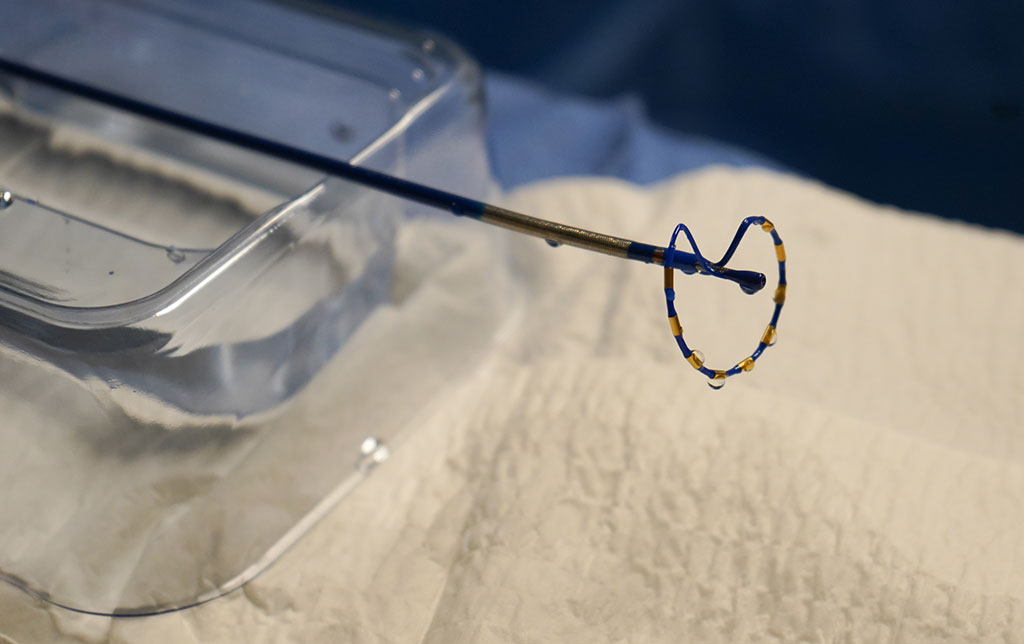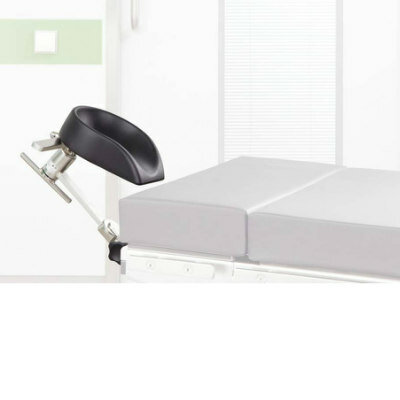Pulsed Electric Field Technology Treats Atrial Fibrillation
|
By HospiMedica International staff writers Posted on 05 Mar 2020 |

Image: The PulseSelect PFA system ablation probe (Photo courtesy of OSU)
A novel atrial fibrillation (AF) ablation system uses non-thermal pulsed field ablation (PFA) technology to interrupt cardiac pathways and AF triggers.
The Medtronic (Dublin, Ireland) PulseSelect PFA System is designed to generate a train of high voltage, short duration, bipolar and biphasic pulsed electric fields in order to selectively target and ablate cardiomyocytes, while avoiding other types of tissue. The system can also be used for pulmonary vein isolation (PVI) treatments. A prospective, multi-center, non-randomized, worldwide trial called the PULSED AF study has been launched in the U.S., Australia, and Canada, to treat AF patients with the Medtronic PulseSelect PFA System.
“As a global leader in the treatment of cardiac arrhythmias, Medtronic is constantly evaluating new and existing therapies to better meet the needs of patients and the physicians who care for them,” said Rebecca Seidel, vice president and general manager of AF solutions, part of the cardiac and vascular group at Medtronic. “The PULSED AF study is another example of our commitment to meaningful innovation, and a major step forward in the development of a diverse set of therapy options for atrial fibrillation patients.”
“This new technology is potentially everything we've hoped for in catheter ablation. It's easier to use, more efficient, and will be better for patients because there's less risk of damage to surrounding tissue and a shorter recovery time,” said electrophysiologist John Hummel, MD, of Ohio State University (OSU; Columbus, USA), who performed the first procedure in the United States. “This type of energy delivery is non-thermal, and heart muscle cells are uniquely sensitive to it, thus helping to avoid affecting other types of tissue around the heart. It's also very rapid and will likely significantly cut down on surgery time.”
PVI is a catheter ablation technique developed to prevent focal triggers in the pulmonary veins from initiating episodes of persistent atrial fibrillation (PsAF). Although the procedure initially involved focal ablation with a catheter directly in the pulmonary veins, isolating the pulmonary veins by applying ablation energy at their junction with the left atrium is more effective. The PVI procedure is most suitable for patients whose recurring symptomatic episodes of AF have not been suppressed by anti-arrhythmic drugs or who do not wish to take long-term anti-arrhythmic or anticoagulation medications.
Related Links:
Medtronic
The Medtronic (Dublin, Ireland) PulseSelect PFA System is designed to generate a train of high voltage, short duration, bipolar and biphasic pulsed electric fields in order to selectively target and ablate cardiomyocytes, while avoiding other types of tissue. The system can also be used for pulmonary vein isolation (PVI) treatments. A prospective, multi-center, non-randomized, worldwide trial called the PULSED AF study has been launched in the U.S., Australia, and Canada, to treat AF patients with the Medtronic PulseSelect PFA System.
“As a global leader in the treatment of cardiac arrhythmias, Medtronic is constantly evaluating new and existing therapies to better meet the needs of patients and the physicians who care for them,” said Rebecca Seidel, vice president and general manager of AF solutions, part of the cardiac and vascular group at Medtronic. “The PULSED AF study is another example of our commitment to meaningful innovation, and a major step forward in the development of a diverse set of therapy options for atrial fibrillation patients.”
“This new technology is potentially everything we've hoped for in catheter ablation. It's easier to use, more efficient, and will be better for patients because there's less risk of damage to surrounding tissue and a shorter recovery time,” said electrophysiologist John Hummel, MD, of Ohio State University (OSU; Columbus, USA), who performed the first procedure in the United States. “This type of energy delivery is non-thermal, and heart muscle cells are uniquely sensitive to it, thus helping to avoid affecting other types of tissue around the heart. It's also very rapid and will likely significantly cut down on surgery time.”
PVI is a catheter ablation technique developed to prevent focal triggers in the pulmonary veins from initiating episodes of persistent atrial fibrillation (PsAF). Although the procedure initially involved focal ablation with a catheter directly in the pulmonary veins, isolating the pulmonary veins by applying ablation energy at their junction with the left atrium is more effective. The PVI procedure is most suitable for patients whose recurring symptomatic episodes of AF have not been suppressed by anti-arrhythmic drugs or who do not wish to take long-term anti-arrhythmic or anticoagulation medications.
Related Links:
Medtronic
Latest Surgical Techniques News
- Robotic Assistant Delivers Ultra-Precision Injections with Rapid Setup Times
- Minimally Invasive Endoscopic Surgery Improves Severe Stroke Outcomes
- Novel Glue Prevents Complications After Breast Cancer Surgery
- Breakthrough Brain Implant Enables Safer and More Precise Drug Delivery
- Bioadhesive Sponge Stops Uncontrolled Internal Bleeding During Surgery
- Revolutionary Nano Bone Material to Accelerate Surgery and Healing
- Superior Orthopedic Implants Combat Infections and Quicken Healing After Surgery
- Laser-Based Technique Eliminates Pancreatic Tumors While Protecting Healthy Tissue
- Surgical Treatment of Severe Carotid Artery Stenosis Benefits Blood-Brain Barrier
- Revolutionary Reusable Duodenoscope Introduces 68-Minute Sterilization
- World's First Transcatheter Smart Implant Monitors and Treats Congestion in Heart Failure
- Hybrid Endoscope Marks Breakthrough in Surgical Visualization
- Robot-Assisted Bronchoscope Diagnoses Tiniest and Hardest to Reach Lung Tumors
- Diamond-Titanium Device Paves Way for Smart Implants that Warn of Disease Progression
- 3D Printable Bio-Active Glass Could Serve as Bone Replacement Material
- Spider-Inspired Magnetic Soft Robots to Perform Minimally Invasive GI Tract Procedures
Channels
Critical Care
view channel
Wearable Patch for Early Skin Cancer Detection to Reduce Unnecessary Biopsies
Skin cancer remains one of the most dangerous and common cancers worldwide, with early detection crucial for improving survival rates. Traditional diagnostic methods—visual inspections, imaging, and biopsies—can... Read more
Pulse Oximeter Index Offers Non-Invasive Guides for Fluid Therapy
In patients with acute circulatory failure, deciding whether to administer intravenous fluids is often a life-or-death decision. Too little fluid can leave organs underperfused, while too much can cause... Read morePatient Care
view channel
Revolutionary Automatic IV-Line Flushing Device to Enhance Infusion Care
More than 80% of in-hospital patients receive intravenous (IV) therapy. Every dose of IV medicine delivered in a small volume (<250 mL) infusion bag should be followed by subsequent flushing to ensure... Read more
VR Training Tool Combats Contamination of Portable Medical Equipment
Healthcare-associated infections (HAIs) impact one in every 31 patients, cause nearly 100,000 deaths each year, and cost USD 28.4 billion in direct medical expenses. Notably, up to 75% of these infections... Read more
Portable Biosensor Platform to Reduce Hospital-Acquired Infections
Approximately 4 million patients in the European Union acquire healthcare-associated infections (HAIs) or nosocomial infections each year, with around 37,000 deaths directly resulting from these infections,... Read moreFirst-Of-Its-Kind Portable Germicidal Light Technology Disinfects High-Touch Clinical Surfaces in Seconds
Reducing healthcare-acquired infections (HAIs) remains a pressing issue within global healthcare systems. In the United States alone, 1.7 million patients contract HAIs annually, leading to approximately... Read moreHealth IT
view channel
Printable Molecule-Selective Nanoparticles Enable Mass Production of Wearable Biosensors
The future of medicine is likely to focus on the personalization of healthcare—understanding exactly what an individual requires and delivering the appropriate combination of nutrients, metabolites, and... Read moreBusiness
view channel
Philips and Masimo Partner to Advance Patient Monitoring Measurement Technologies
Royal Philips (Amsterdam, Netherlands) and Masimo (Irvine, California, USA) have renewed their multi-year strategic collaboration, combining Philips’ expertise in patient monitoring with Masimo’s noninvasive... Read more
B. Braun Acquires Digital Microsurgery Company True Digital Surgery
The high-end microsurgery market in neurosurgery, spine, and ENT is undergoing a significant transformation. Traditional analog microscopes are giving way to digital exoscopes, which provide improved visualization,... Read more
CMEF 2025 to Promote Holistic and High-Quality Development of Medical and Health Industry
The 92nd China International Medical Equipment Fair (CMEF 2025) Autumn Exhibition is scheduled to be held from September 26 to 29 at the China Import and Export Fair Complex (Canton Fair Complex) in Guangzhou.... Read more














